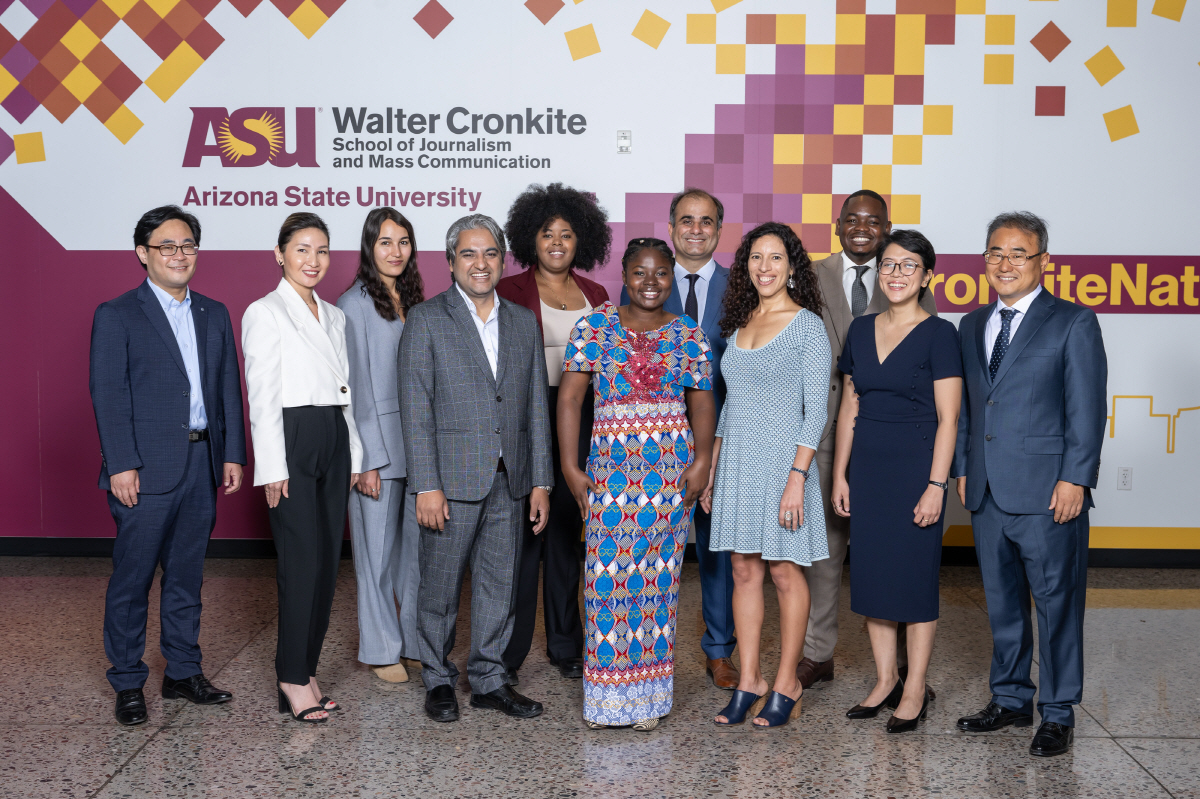
The rigors of climbing the scholastic ladder at one of the Philippines’ “Big Four” universities can’t keep Jeremaiah Opiniano, a journalist with a Ph.D., from playing the lottery.
Despite the slim odds of one in 29 million to win the ₱100-million ($2 million) jackpot, he already has plans for the money: to build a local news company.
He is no stranger to the task. In 2011, Opiniano spent personal savings of less than ₱500,000 (around $10,000) to launch The Filipino Connection with two journalist friends. The news website, which also publishes a weekly newspaper, operates out of Lipa, Batangas, an emerging urban zone 75 kilometers south of Manila.
The Connection, inspired by California’s San Jose Mercury News where Opiniano had completed a fellowship, adopted a style of oblique, show-don’t-tell critiques of those in power. And it worked the way local news is meant to. Readers effectively demanded action from the Lipa government, like when officials cleared long-piled trash on a major highway.
Opiniano and his partners wanted to raise the bar for news in communities and, naturally, to earn from it. But quality doesn’t always bring in cash. Working only on The Connection part-time, the journalist-proprietors couldn’t always go after elusive ad placements. Besides, the few local businesses willing to advertise mostly wanted to pay for space in the print edition—and printing cost even more money.
Widened access to the internet in the Philippines, currently at 91%, may have lowered barriers for local news entrants, like The Connection. But maintaining online visibility is an added expense in places where a reliable source of revenue—publishing judicial notices and calls for bidding—is only valid in print form. Community publishers online are thus caught in a cycle, struggling to fund free content while striving for reach and attention.
“When it comes to [local] media as a business, if you want to do it independently, it’s tough. You really have to win the lottery,” Opiniano said. “It’s capital intensive.”
Financial constraints could partly explain why the internet has largely failed to shift the pattern of community media ownership since the late 1980s. This period saw “alternative” newspapers moving to the mainstream when the Marcos dictatorship was toppled and democracy was restored. Florangel Braid, a framer of the 1986 Constitution who spent a career in journalism studies, said economic control in the local news industry has mostly remained “in the hands of capitalists” to this day, particularly “provincial clans” dabbling in politics and other interests such as mining and utilities that conflict with journalists’ watchdog role.
While hugely profitable in the past, newspapers and television news in the Philippines have seen a significant decline in audience, from 22% to 14% and 66% to 52% respectively, over the past three years, data from the Reuters Institute’s Digital News Report suggest.
Most Filipinos now get their news online, where they spend about 4 hours daily on social media alone—twice as long as the global average. The shift in habits drives traffic to ad-supported, Manila-based national news outlets that set up websites in the 2000s, but it guts under-resourced local news providers that were slow to adapt.
Yas Ocampo, a Davao-based journalist and social media manager, saw the struggles of traditional newsrooms firsthand. “They stuck too much to legacy journalism and when shit hit the fan, it was up to us, social media people, to say the sky is falling, but nobody listened to us,” he said in a personal interview.
The COVID-19 pandemic further burdened community dailies that had to cut down page count from 40 to 12 or fewer and reduce print runs to thrice weekly. “Now, community news organizations have realized that the pivot to digital is the necessary thing to do,” Ocampo said.
Even those that embraced a digital-first approach could not earn enough revenue to sustain operations or offset the losses from print. SunStar, a leading local newspaper chain with an early online presence, was forced to cease operations in a key urban market and lay off staff in other areas.
U.S. scholars have increasingly stressed that reliable news and information “feeds democracy at a grassroots level.” Areas with little to no access to it, called “news deserts,” are more likely to vote for one party, more vulnerable to misinformation, less engaged in city and community affairs, and less capable of holding public officials accountable.
In the Philippines, as cash-strapped local media are playing catch-up, and audiences are glued to social networks’ endless feeds, a growing information void in communities has raised concern.
Further weakening coverage is the absence of top broadcaster ABS-CBN and its multi-lingual stations that reached remote locations. Former president Duterte’s congress closed down the network in 2020 in what was considered the single greatest blow to critical media.

The shutdown made access to local journalism even more unequal, since existing news providers are mostly based in urbanized areas. Researchers at the Ateneo de Manila University’s Asian Center for Journalism (ACFJ), who conducted the first-ever mapping of “credible” national and local news websites earlier this year, found that a majority are concentrated in Luzon, the northernmost of the three main island groups, with 63. Among these, 34 are based in the capital region Metro Manila alone, surpassing the count in the whole of Visayas (24) and in Mindanao (17).
The index screened out active disinformation actors and those obviously linked to politicians like President Ferdinand “Bongbong” Marcos Jr. as components of a propaganda machinery. These sites and pages, such as those of Sonshine Media, owned by a Mindanao-based cult leader that U.S. federal investigators have charged for labor and sex trafficking, nevertheless populate Filipinos’ digital spaces with wide reach.
For journalists-researchers Raizza Bello and Robbin Dagle, who presented the ACFJ data at a symposium in Austin, TX, the abundance of all sorts of online content is no guarantee that the kind of news local audiences need will reach them. Filipino communities are, in fact, “severely lacking sources of reliable and well-vetted information,” they wrote.
A similar index of local radio stations, on the other hand, can give a more complete accounting of areas possibly deprived of crucial news. “We suspect that radio is a significant source… We don’t think local TV, after ABS-CBN, is as robust,” Dagle said in a separate interview.
In the face of market shifts and dwindling revenues, a landscape of news alternatives appears to be taking shape. ACFJ researchers note a potential trend: “forms of hyperlocal journalism” produced independently from large publishers. Individual journalists and micro-news outlets running Facebook pages and groups are becoming sources of accurate and timely news in towns and provinces.
A “crude financial model,” incorporating cross-promotions with local advertisers and possible earnings from live video, supports some efforts researchers have seen, Dagle said.
Rolando Estabillo, publisher of newspaper Manila Standard, had recognized the “emergence of new journalism” by Facebook pages, bloggers and YouTubers, though they are not yet “fully trained and made aware of their responsibilities.”
“But they ought not to be ostracized by the self-righteous. Their presence in our midst is the sign of the future that is actually already upon us,” Estabillo, who is also chair of the Philippine Press Institute (PPI), said at an event in August.
Connecting advertisers with trusted platforms is seen as a way to arrest the local news decline. Last year, a top telco and a leading dairy company in the Philippines committed to enlist in “Ads for News,” a global initiative of media nonprofit Internews to direct ad spending to local websites that partners like the ACFJ has vetted as “brand-safe.”
There are efforts, too, to shore up existing local newsrooms with skills and tools to stay relevant in their communities. PPI, an association of national and local papers, has conducted training for its 63 member-newspapers to reach audiences, engage with on-ground stakeholders and incorporate digital revenue streams.
“We knew we had to recalibrate our work. It’s not just about relevance and longevity, it’s about turning things around when we’ve lost spaces for journalists and that those spaces have been taken away,” said Ariel Sebellino, PPI executive director, in a personal interview.
While initiatives and alternatives are growing, local journalism by and large still needs a financial savior. If attempts so far in the U.S. serve as any indication, the lack of resources and experience, coupled with uncertain funding, makes many of them unsustainable.

For Braid, the 93-year-old constitutional framer, reviving journalism bottom-up is worth the failed attempts; it would nourish democracy.
“The role of the community is to educate the center, because that’s where the wisdom lies. It’s where you have direct experience with nature, with all the problems of poverty,” she said.
Entrepreneurial journalists like Opiniano, who has yet to recoup the savings he sunk into The Filipino Connection 10 years ago, have found no one-size-fits-all model to save community journalism. “You need ample capital,” he says, and “a combination of revenue streams.”
Despite the odds against local journalists, though, Opiniano is still willing to take his chances, and it is in local news he keeps betting on.
Even if it means buying another lottery ticket.




